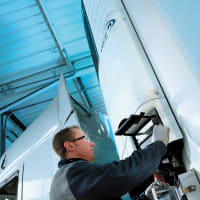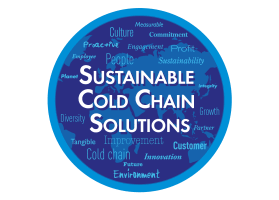
Cool By Carrier
A key link in the chain of life
Respect for the cold chain is crucial to ensure goods are delivered in optimal condition to customers. It requires expertise that only a specialist can provide. Carrier Transicold is dedicated to maintaining your cold chain and maximizing cost efficiency, while limiting environmental impact.
Developing innovative cold chain solutions is ingrained in the culture of Carrier Transicold, where respect for the cold chain is crucial to ensure perishable, fresh and frozen goods are delivered in optimum condition to customers.
E-DRIVE™ Experienced Technology Since 1999The E-DRIVE all-electric technology removes mechanical transmissions found in belt-driven technology by transforming engine power into electricity. This unique and patented solution delivers superior cold chain performance while reducing CO2 footprint and total cost of ownership :
|
Save Fuel and Weight with ECO-DRIVE
The ECO-DRIVE is a power module, which is fitted to the side of the truck's chassis. 400 volt / 50 Hz is delivered and constantly available. This pump is connected to the truck engine via a PTO (power take off). The hydraulic system drives a generator located inside the power module delivering a constant 400 volt / 50 Hz.
A control is integrated within the hydraulic system, called X-Flow. This innovative system operates independent of the truck’s engine speed and ensures 100 % capacity is always available. The system communicates with the CAN bus of the truck.
Before Loading
- Especially the inner side: walls, roof and floor
- Heat ingresses the trailer body through products, open doors and trailer floor, sides and roof.
- When not in use try to park in the shade.
- To limit the flow of cold air to the outside, they have to be:
- not too old
- with a proper length down to the floor
During Loading
- Product should always be loaded at the correct temperature and from a refrigerated loading bay.
- Do not obstruct the evaporator with the loaded goods. Make sure that air circulation is not impeded.
- Beware of orientation of pallets that should allow airflow to the rear of the body, through and under the load.
- Do not load up to the ceiling that will cause short cycling.
- Do not mix refrigerated and dry goods in the same compartment.
- The second compartment cannot be cooled by a fan from the first compartment for hygiene reason
After Loading
- Cold air is heavier than hot air. Opening doors with no curtains leads warmer air to replace cooler air.
- Operating unit when doors are opened may result in frost and increase energy consumption
- During loading, check the internal temperature of the goods to be transported.
- The below information is an extract from ATP Handbook 2011. It is given for reference purposes only, and may be overridden on the transporter or the consignee’s advice. More detailed information may be obtained from your Carrier Transicold distributor.
Frozen Foodstuffs
|
-20°C
|
Ice and ice cream
|
|
-18°C
|
Frozen or quick (deep)-frozen fish, fish products, molluscs and crustaceans and all other quick (deep)-frozen foodstuffs
|
|
-12°C
|
All frozen foodstuff (except butter)
|
|
-10°C
|
Butter
|
Chilled Foodstuffs
|
On melting ice or at temperature of melting ice
|
Untreated fish, molluscs and crustaceans (except for live fish, live molluscs and live crustaceans)
|
|
Either at +2°C or at temperature indicated on the label and/or on the transport document
|
Minced meat (and any preparations thereof)
|
|
+3°C
|
Red offal (and any preparations thereof)
|
|
+4°C
|
Game (other than large game), poultry (and any preparations thereof) and rabbits
|
|
Either at +6°C or at temperature indicated on the label and/or on the transport documents
|
Meat products (except for fully treated by salting, smoking, drying, or sterilization)
|
|
+6°C
|
Pasteurized milk, fresh dairy products (yoghurt, kefir, cream and fresh cheese*)
|
|
Ready cooked foodstuffs (meat, fish, vegetables)
|
|
|
Ready to eat prepared raw vegetables (which have been diced, sliced or otherwise size reducted, but excluding those which have only been washed, peeled or simply cut in half) and vegetables products
|
|
|
Fishs products (except for product fully trated by salting, smoking, drying, or sterilization) not listed above
|
|
|
Raw milk (when milk is collected from the farm for immediate processing, the temperature may rise during carriage to +10°C)
|
|
|
+7°C
|
Red meat (and any preparations thereof) and large game (other than red offal)
|
Keeping your cold chain cost effective is a major challenge. While on the road, it’s important to minimize energy consumption while maintaining performance.
Prepare Transportation
- Make sure boxes are undamaged to avoid cool air to seep out quickly and have the motor run more frequently.
- Use partition walls to cool loads individually and enable return packaging to be kept aside.
Make the Best Usage of your Refrigeration Unit
- Use the built-in standby to reduce energy consumption when parked, or during loading and unloading.
- Use the control system to select the setting adapted to the load transported.
Maintain the Unit
- Perform preventive maintenance before entering busy periods and intensive usage to ensure your equipment is ready.
- Regularly maintain your refrigeration unit following the number of running hours to avoid breakdown and allow for adjustments.
Carrier Transicold offers a wide range of solutions to preserve freshness, ensure safety during transport and enhance the overall appearance and quality of food and beverage retail.
Carrier Transicold is your Cold Chain Partner throughout the Cold Chain
- In the transport by sea with our container solutions
- In the transport by road with the truck and trailer solutions
- To ensure cold chain visibility with Sensitech®
- Until the supermarket, with our commercial refrigeration solutions
FOREWORD

Major global events such as the 2015 Paris Climate Conference (COP21) and the Montreal Protocol 2016 Kigali Agreement have focused the international spotlight on a more rapid move towards low emissions and cleaner energy.
At Carrier Transicold it is our mission to help make the world a better place to live. Our transport refrigeration systems have long served an important need, delivering food and other temperature-sensitive goods. It’s a heritage we’re proud of and one that we intend to build further with more sustainable and innovative transport refrigeration solutions.
As a result, the pace of change in the transport refrigeration sector is high, and fleet owners must understand important new legislation being introduced to improve environmental protection.
At Carrier Transicold it is our mission to help make the world a better place to live. Our transport refrigeration systems have long served an important need, delivering food and other temperature-sensitive goods. It’s a heritage we’re proud of and one that we intend to build further with more sustainable and innovative transport refrigeration solutions.
Our teams are working hard to develop new technologies and services to meet the challenges ahead. From an operations perspective, we believe that reducing the environmental impact needs to be done while maintaining efficiency levels. As not every new solution brought to market will suit every fleet, we are focused on providing a range of solutions which can be mission-matched to each customer’s individual requirements.
F-GAS REGULATION EU/517/2014
Since 1 January 2015, F-Gases have been subject to a strict new European Union legislation which aims to significantly reduce the emissions from the use of fluorinated gases.
EU STAGE V ENGINE EMISSIONS REGULATION EU/2016/1628
Commercial vehicles used in road transport are subject to strict regulations which keep their emissions levels in check, with the latest vans and trucks meeting Euro VI standards.
However, the engines powering transport refrigeration units have typically been regulated differently until now.
PIEK LABEL
Urban noise can have a serious effect on quality of life; it can make hearing, concentrating, and working more difficult, as well as potentially disturbing sleep, which can result in stress and fatigue.
ATP REGULATIONS
ATP is the name given to the agreement on the International Transport of Perishable Foodstuffs, which was originated by the Inland Transport Committee of the United Nations Economic Committee for Europe (UNECE) in 1970-71.

